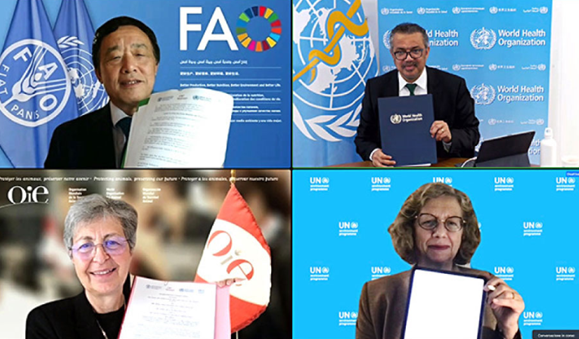Who We Are

The Quadripartite Joint Secretariat on AMR (QJS) consolidates cooperation between the Food and Agriculture Organization (FAO) of the United Nations, the United Nations Environment Programme (UNEP), the World Health Organization (WHO) and the World Organisation for Animal Health (WOAH), drawing on their core mandates to support the global response to AMR across the One Health spectrum. This is achieved through global advocacy, technical guidance, political engagement, creation and promotion of a shared vision and goals, and providing Secretariat services for global governance structures.
The QJS was established following the request by the United Nations Secretary-General to the Executive Leaders of the then Tripartite organizations (FAO, WHO and WOAH) to establish a Joint Secretariat to step up their efforts to tackle antimicrobial resistance including the implementation of the Inter-agency Coordinating Group on AMR (IACG) recommendations.
The QJS is hosted by WHO with dedicated liaison officers and responsible officers from FAO, UNEP, WHO and WOAH. It manages the day-to-day operations of the joint work of the Quadripartite organizations on AMR.
FAO, UNEP and WHO are UN organizations with headquarters in Rome, Nairobi and Geneva, respectively, and with presence at regional and country levels. WOAH, with Headquarters based in Paris, is an intergovernmental, non-UN organization established in 1924, with a regional and sub-regional presence. A brief synopsis of AMR-related activities being supported by the respective organizations, in addition to their joint work, is as follows:
What We Do
Key functions
The following are the key functions of the QJS aimed at supporting the execution of the core mandate and advancing the joint response of the Quadripartite organizations to antimicrobial resistance:
- Support global promotion, advocacy and political engagement: Promotes the One Health approach and joint activities of the Quadripartite organizations as critical players in the global response through high-level communication, advocacy and political engagement, and the creation of an enabling environment.
- Support to global governance structures: Manages and supports the Global Leaders Group on AMR, Independent Panel on Evidence for Action and the AMR Multi-Stakeholder Partnership Platform on behalf of the Quadripartite organizations based on their terms of reference and in close consultation with the UN Secretary-General’s office.
- Coordination of interagency engagement and partnership: Facilitates the engagement of the specialized agencies of the UN and intergovernmental organisations through the development of a shared goal and voluntary division of labour based on their mandate and comparative advantage to foster collaboration around priority objectives, prevent duplication of efforts and to gain synergies and efficiencies.
- Coordination and monitoring of Quadripartite workplan implementation: The QJS facilitates the collective development, updating, coordination, monitoring and reporting of the implementation of the joint Quadripartite workplans in close collaboration with the relevant teams responsible for executing the activities across the four organizations.
- Mapping gaps and opportunities: Through its facilitation, coordination and monitoring role of the implementation of the joint Quadripartite workplan, the QJS continuously monitors for strategic gaps and opportunities in the Quadripartite response on antimicrobial resistance and bring them to the attention of the Quadripartite Executive Committee for decision.
- Coordination of the Multi-Partner Trust Fund: The QJS is responsible for the coordination of the AMR Multi-Partner Trust Fund as well as managing the Steering Committee of the Trust Fund, while the UNDP Multi-Partner Trust Fund Office manages the receipt, administration and disbursement of funds to the Participating Organizations, financial reporting and consolidation.
The current flagship initiatives include the following:
- Multi-Partner Trust Fund
- AMR Multi-stakeholder Partnership Platform
- Global Leaders Group on AMR
- Technical Work
- World AMR Awareness Week
How We Work
The QJS is hosted in WHO with dedicated liaison officers and technical staff from FAO, UNEP and WOAH and coordinates the AMR activities derived from the Strategic Framework for Collaboration. The organisations draw on their individual core mandates and comparative advantages to collectively address needs of the global response across the One Health spectrum. This is based on a functional arrangement.
